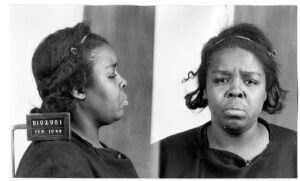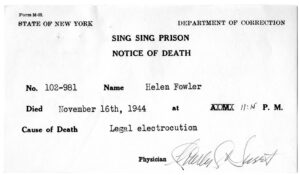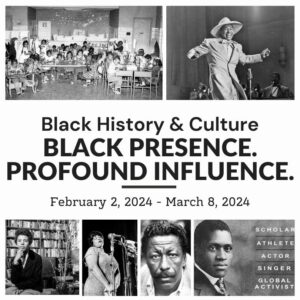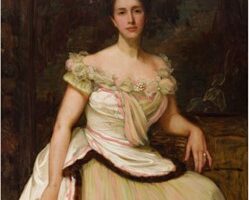
On Nov. 16, 1944, Helen Ray Fowler died in Sing Sing prison’s electric chair, becoming the only Black woman legally executed in New York State.
Her death at age 37 followed a guilty verdict that even the jury wasn’t convinced was just.
Fowler, a mother struggling to raise five children while her husband was off at war, was innocent of the murder that consigned her to death, according to a new play that debuts in February at Bethany Arts Community in Ossining.
Ossining Village Historian Joyce Sharrock-Cole spent the past year digging into Fowler’s past in a quest to right a historical wrong. The result is The Execution of Helen Ray Fowler.
The two-act drama, on which Sharrock-Cole collaborated with playwright Misha Templar Sinclair, will be presented over two weekends in February. Actress Donna James leads a 15-member cast under the direction of Mel Hancock.
The play grew out of a presentation by Sharrock-Cole, a lifelong Ossining resident, about four women who were executed at Sing Sing.
“Their stories were so compelling, I said these stories have to be told,” said Sharrock-Cole, curator of Bethany’s annual Black History and Culture exhibit. “Most people don’t even know women were at Sing Sing nor that they were executed and what life was like for them.”

Donna James, of Ossining, has appeared in many local productions, including recently at Lindhurst After Dark at the Gothic Revival mansion in Tarrytown. She also portrayed Madam CJ Walker in Sharrock-Cole’s exhibit at Bethany.
Death sentence
Helen Fowler ran a boarding house in the red-light district in Niagara Falls when, according to Bethany’s production, “a fit of jealousy and a series of bad decisions results in a man’s death.”
The victim was William Fowler, who Helen Fowler was not related to, although press reports and even her own death certificate listed him as her husband.
William Fowler was out for a night on the town in Niagara Falls on Oct. 30, 1943, when he was killed by a blow to the head during a robbery at Helen Fowler’s rooming house, according to press coverage. She and one of her “hothead” boarders, George Knight, were charged with first-degree murder.
A motion by the defendants to separate their trials was denied. After three days of conflicting testimony, Fowler and Knight were convicted of murder — but not before the jury asked the judge whether two people could be found guilty of murder when only one had done the killing. The judge instructed them that both parties engaged in the commission of a felony were equally guilty.

A week later, Fowler and Knight were sentenced to die in Sing Sing’s electric chair, infamously known as “Old Sparky.”
Several appeals by Fowler and her lawyers failed to obtain a new trial or prevent her execution. She was one of four people executed at Sing Sing that night, including her co-defendant and two other men.
“She was guilty of moving the body but in today’s standards she wouldn’t have died for it. She didn’t kill him,” Sharrock-Cole said. “She wasn’t guilty of the crime.”
Fowler’s body was unclaimed by her family after her execution and she was supposedly buried by the state in Adams Corners in Putnam County, although Sharrock-Cole said there was no record of her body there.
Press coverage about Fowler’s life “doesn’t do her justice,” Sharrock-Cole said, portraying her as “this brute woman” and inaccurately speculating on her relationship with her children and with the man who committed the murder.
“The fact that her case was the first case in the Niagara Falls area that included female jurors is big, and the fact that you call up there and no one knows this case baffles me,” she said.
Sharrock-Cole added: “With the review recently of the criminal justice system, so much has been talked about, that’s why it’s so relevant today. By today’s standards, would she have met the same fate? How would they have treated it? And the fact that she was in jail in February, dead by November, and people accused of the same thing, other women were in there for a really long time before they were killed.”
Describing the play about Fowler’s life, Sharrock-Cole said: “There’s so much that people can see themselves in. A woman raising her children, and how hard it is without your husband at home, and it talks about loneliness, and it goes into a little bit of the trauma of her life.”
Highlighting Black history
The play is part of Bethany’s Black History & Culture: Black Presence. Profound Influence exhibition highlighting Black contributions throughout American history, which runs from Feb. 2 through March 8.
The exhibition, curated by Sharrock-Cole, includes oral history accounts and genealogical research to unearth the stories of Black entrepreneurs and Black organizations from all facets of the community’s business and social life.
Programming will include talks, a film screening, guided tours, and a living museum with local actors. Events will take place in person, online, and traveling throughout the year with the exhibition’s History Walls.
If you go:
- What: The Execution of Helen Ray Fowler
- When: Friday, Feb. 16 at 7 p.m.; Saturday, Feb. 17 at 7 p.m.; Sunday, Feb.18 at 3 p.m.; Friday, Feb. 23 at 7 p.m.; Saturday, Feb. 24 at 7 p.m.; Sunday, Feb. 25 at 3 p.m.
- Where: Bethany Arts Community, 40 Somerstown Road, Ossining
- For mature audiences only. Highly suggested for audiences 18 and older
- Tickets: $30 general admission; $25 senior/student
- Information: bethanyarts.org/calendar/helenrayfowler/
- For more about Black History & Culture: Black Presence. Profound Influence, visit bethanyarts.org, call 914 944-4278 or email info@bethanyarts.org







Sorry, but your information is rather inaccurate.
Subsequent articles have cast doubt not only on the fairness of the trial but also the effort of the the counsel of record who went on to some politcal fame in the State of New York.
Her daughter’s testimony should have been disallowed along with the testimony of her 8 year old son. And according to the articles, it’s been suggested that defense counsel failed her in the trial by not crossing those witnesses or bringing up the fact that they may have been coerced. Even for 1944, there were ways of saving her from the chair.
https://niagarafallsreporter.com/fowler.html
https://crimescribe.com/2019/11/16/on-this-day-in-1944-helen-ray-fowler-and-george-knight/
Anthony –
Looking into accounts of Fowler’s case, her tangled relationship with her daughter Genevieve Person included an assault for which they were both charged and the daughter was awaiting sentencing. The daughter reportedly drank a cup of cleaning fluid after her testimony in an apparent suicide attempt.
Helen’s younger children from a different marriage, who testified as witnesses, did not corroborate Genevieve Person’s account of their mother’s role in the killing.
Robert,
Buffalo News, February 10, 1944, page 28
JURY TOLD DETAILS OF FATAL BEATING IN MURDER TRIAL
Written statements In which each accused the other with the actual slaying were admitted ‘Into evidence by Supreme Court Justice William H Munson Wednesday evening In the first-degree murder trial of Mrs Helen Fowler 36 and George F Knight 25 Niagara Falls Negroes
They are charged with killing George W Fowler 63-year-old Ransomviile service station operator last Oct 30 after robbing him of Siono At the night session which had been ordered by Justice Munson to speed up the trial two aigned statements allegedly made by Knight after the victim’s body was recovered nude from the Niagara River on Dec 8 were read to the jury’
Statements Read In one statement
Knight was quoted as saying that Mrs Fowler robbed and killed the Ransomville man during Knight’s absence from her home where the slaying is alleged to have occurred In tha second statement Knight admitted knocking down the victim a white man and taking his wallet.
The statement alto quoted Knight as saying that Mrs Fowler killed the man so he would not report the robbery Both statements related that Knight and the woman took the body from her home at 144 Memorial Pkwy Niagara Falls In a borrowed automobile to the North Grand Island Bridge the following night and threw it into the river
Niagara Falls Police Capt. Robert Fitzsimmons testified that Mrs Fowler made a statement accusing Knight of killing the service station operator The policeman said Mrs Fowler told him she took a vase away from Knight to prevent Knight from hitting the victim with It t Beaten With Hammer “Mrs Fowler said that Knight beat and kicked the white man and jumped on his stomach”
Capt. Fitzsimmons related “Her statement was typewritten and rewritten twice to make certain changes she requested In the end she told us everything in the statement was true but that she would not sign it until she had had the advice of her attorney” The unsigned statement was admitted Into evidence by Justice Munson
At Wednesday afternoon’s session the 18-year-old daughter of Mrs Fowler by a previous marriage Miss Genevieve Persons testified that she saw the Ransomville man begging for mercy beaten to death with a hammer by Knight in her mother’s home Miss Persons said her mother knelt beside the man and once sat on him during the beating.
In the case of Helen Fowler, believe there are notable aspects that question the fairness of her trial and subsequent execution.
It appears that there were instances where other women, particularly white women, faced more serious charges supported by conclusive evidence, yet they did not experience such swift and irreversible consequences. Moreover, the influence of racial bias during that period in American history raises concerns about whether Helen Fowler received a fair judgment. Given the prevailing racism of the time, it seems plausible that her race played a role in the treatment she received compared to her white counterparts.
While acknowledging that the law was applied as it existed at the time, it’s crucial to consider whether the punishment aligns with the circumstances of the case. Some argue that life imprisonment might have been a more appropriate sentence, and there are factors, such as her complex relationship with her daughters and potential police manipulation, that were not thoroughly explored during her defense.
In essence, the case of Helen Fowler is multifaceted, and the swift execution, especially considering the racial context and potential mitigating factors, raises questions about the fairness of the legal proceedings. It is worth reflecting on whether the law, despite being in place, was administered justly in her case.
Anthony: The trial accounts I have read describe Helen’s daughter’s testifying that her mother helped dump the victim’s body, but did not describe her as being an accomplice to the murder.
Horrible story and seems so unfair!.,
Helen Fowler was a participant in the homicide of 63 year old victim George William Fowler (no relation). At Helen’s trial, her own 18 year daughter testified in court that she saw George Knight beating George Fowler with a hammer to the head while Helen Fowler knelt beside the victim and sat down on him to keep him pinned to the floor during the fatal assault and robbery. Then Helen went with Knight to take the body of George Fowler in a car and dump it off the North Grand Island Bridge.
She was held accountable under the law of parties and properly punished for the crime under the laws in effect at the time. New York State did not play games with criminals in that era.